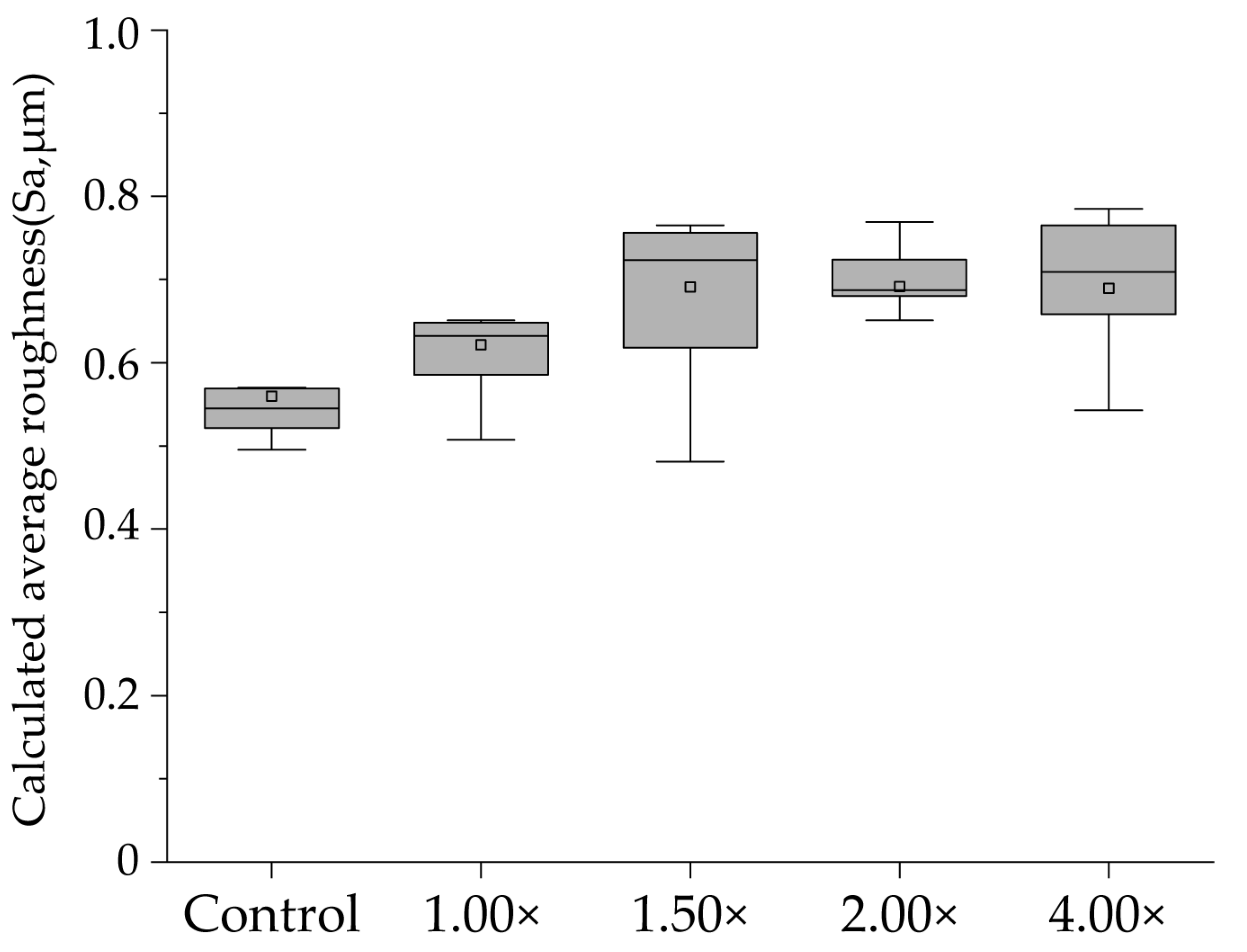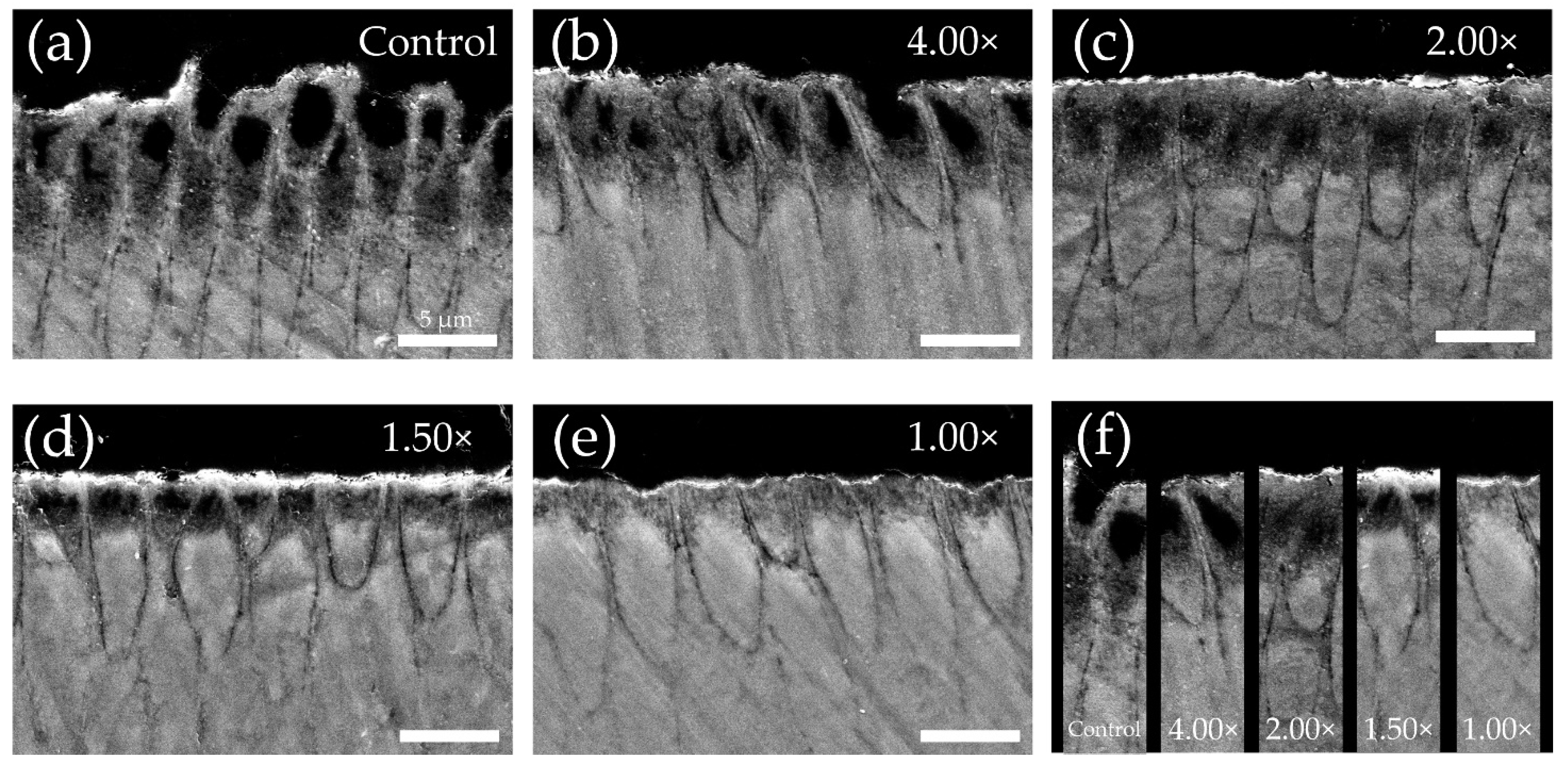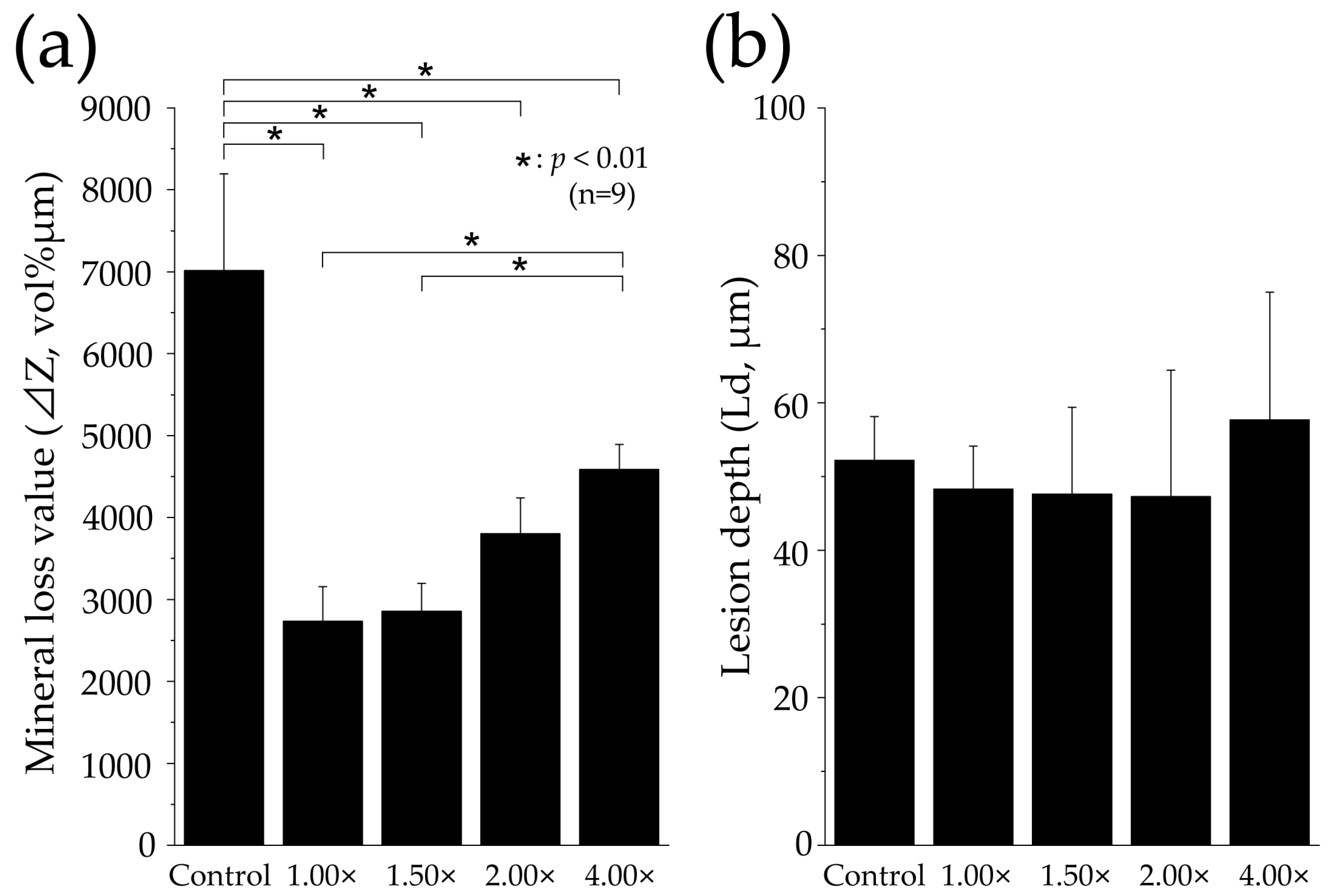Delivery of Low-Diluted Toothpaste during Brushing Improves Enamel Acid Resistance
Abstract
1. Introduction
2. Materials and Methods
2.1. Preparation of Enamel Samples and Toothpaste
2.2. Fluoride Toothpaste Application and pH-Cycling Acid Challenge Experiment
2.3. Three-Dimensional Laser Microscopic Observation
2.4. Vickers Hardness Measurement
2.5. Cross-Sectional Morphology through Scanning Electron Microscopy
2.6. Contact Microradiography (CMR)
2.7. Statistical Analysis
3. Results
3.1. Step Height Profiles Measured by 3D Laser Microscopy after pH-Cycling
3.2. Calculated Average Roughness after pH-Cycling
3.3. Micro-Vickers Hardness and Its Changes after pH-Cycling
3.4. Cross-Sectional Scanning Electron Microscope Observations after pH-Cycling
3.5. Measurement of Mineral Loss Value and Lesion Depth via Contact Microradiography Analysis
4. Discussion
4.1. Comparison of Demineralization Properties by Toothpaste Dilution
4.2. Evaluation Methods, Limitations, and Their Application to Dental Clinical Practice
5. Conclusions
Author Contributions
Funding
Institutional Review Board Statement
Informed Consent Statement
Data Availability Statement
Acknowledgments
Conflicts of Interest
References
- Walsh, T.; Worthington, H.V.; Glenny, A.M.; Marinho, V.C.; Jeroncic, A. Fluoride toothpastes of different concentrations for preventing dental caries. Cochrane Database Syst. Rev. 2019, 3, CD007868. [Google Scholar] [CrossRef] [PubMed]
- The Selection and Use of Essential Medicines. TRS 1035. 2021. Available online: https://www.who.int/publications-detail-redirect/9789240041134 (accessed on 7 June 2023).
- Frencken, J.E.; Sharma, P.; Stenhouse, L.; Green, D.; Laverty, D.; Dietrich, T. Global epidemiology of dental caries and severe periodontitis—A comprehensive review. J. Clin. Periodontol. 2017, 44 (Suppl. S18), S94–S105. [Google Scholar] [CrossRef] [PubMed]
- Whelton, H.P.; Spencer, A.J.; Do, L.G.; Rugg-Gunn, A.J. Fluoride revolution and dental caries: Evolution of policies for global use. J. Dent. Res. 2019, 98, 837–846. [Google Scholar] [CrossRef]
- Marinho, V.C.; Higgins, J.P.; Logan, S.; Sheiham, A. Topical fluoride (toothpastes, mouthrinses, gels or varnishes) for preventing dental caries in children and adolescents. Cochrane Database Syst. Rev. 2003, 2003, CD002782. [Google Scholar] [CrossRef] [PubMed]
- Marinho, V.C.; Chong, L.Y.; Worthington, H.V.; Walsh, T. Fluoride mouthrinses for preventing dental caries in children and adolescents. Cochrane Database Syst. Rev. 2016. [Google Scholar] [CrossRef]
- Chong, L.Y.; Clarkson, J.E.; Dobbyn, L.; Bhakta, S. Slowrelease fluoride devices for the control of dental decay. Cochrane Database Syst. Rev. 2018. [Google Scholar] [CrossRef]
- Wiegand, A.; Buchalla, W.; Attin, T. Review on Fluoride-Releasing Restorative Materials—Fluoride Release and Uptake Characteristics, Antibacterial Activity and Influence on Caries Formation. Dent. Mater. 2007, 23, 343–362. [Google Scholar] [CrossRef]
- Satou, R.; Suzuki, S.; Takayanagi, A.; Yamagishi, A.; Sugihara, N. Modified toothpaste application using prepared toothpaste delivering technique increases interproximal fluoride toothpaste delivery. Clin. Exp. Dent. Res. 2020, 6, 188–196. [Google Scholar] [CrossRef]
- Satou, R.; Yamagishi, A.; Takayanagi, A.; Suzuki, S.; Birkhed, D.; Sugihara, N. Comparison of interproximal delivery and flow characteristics by dentifrice dilution and application of prepared toothpaste delivery technique. PLoS ONE 2022, 17, e0276227. [Google Scholar] [CrossRef]
- Sjögren, K.; Birkhed, D.; Rangmar, B. Effect of a modified toothpaste technique on approximal caries in preschool children. Caries Res. 1995, 29, 435–441. [Google Scholar] [CrossRef]
- Sonbul, H.; Birkhed, D. The preventive effect of a modified fluoride toothpaste technique on approximal caries in adults with high caries prevalence. A 2-year clinical trial. Swed. Dent. J. 2010, 34, 9–16. [Google Scholar] [PubMed]
- Pitts, N.; Duckworth, R.M.; Marsh, P.; Mutti, B.; Parnell, C.; Zero, D. Post-brushing rinsing for the control of dental caries: Exploration of the available evidence to establish what advice we should give our patients. Br. Dent. J. 2012, 212, 315–320. [Google Scholar] [CrossRef] [PubMed]
- Nordström, A.; Birkhed, D. Effect of a third application of toothpastes (1450 and 5000 ppm F), including a ‘massage’ method on fluoride retention and pH drop in plaque. Acta Odontol. Scand. 2013, 71, 50–56. [Google Scholar] [CrossRef] [PubMed]
- Mannaa, A.; Carlén, A.; Zaura, E.; Buijs, M.J.; Bukhary, S.; Lingström, P. Effects of high-fluoride dentifrice (5,000-ppm) on caries-related plaque and salivary variables. Clin. Oral Investig. 2014, 18, 1419–1426. [Google Scholar] [CrossRef]
- Sugai, M.; Matsuda, Y.; Nagayama, M.; Kaga, M.; Yawaka, Y. Comparison of enamel demineralization between deciduous and permanent teeth using the automatic PH-cycling system. Jpn. J. Pediatr. Dent. 2010, 48, 48–55. [Google Scholar] [CrossRef]
- Matsuda, Y.; Murata, Y.; Tanaka, T.; Komatsu, H.; Sano, H. Development of new software as a convenient analysis method for dental microradiography. Dent. Mater. J. 2007, 26, 414–421. [Google Scholar] [CrossRef]
- Matsuda, Y.; Komatsu, H.; Murata, Y.; Tanaka, T.; Sano, H. A newly designed automatic pH-cycling system to simulate daily pH fluctuations. Dent. Mater. J. 2006, 25, 280–285. [Google Scholar] [CrossRef]
- Han, Q.; Li, B.; Zhou, X.; Ge, Y.; Wang, S.; Li, M.; Ren, B.; Wang, H.; Zhang, K.; Xu, H.H.K.; et al. Anti-caries effects of dental adhesives containing quaternary ammonium methacrylates with different chain lengths. Materials 2017, 10, 643. [Google Scholar] [CrossRef]
- Angmar, B.; Carlström, D.; Glas, J.E. Studies on the ultrastructure of dental enamel. IV. The mineralization of normal human enamel. J. Ultrastruct. Res. 1963, 8, 12–23. [Google Scholar] [CrossRef]
- Ten Cate, J.M.; Duijsters, P.P. Influence of fluoride in solution on tooth demineralization. I. Chemical data. Caries Res. 1983, 17, 193–199. [Google Scholar] [CrossRef]
- Ten Cate, J.M.; Duijsters, P.P.E. Influence of fluoride in solution on tooth demineralization. II. Microradiographic data. Caries Res. 1983, 17, 513–519. [Google Scholar] [CrossRef] [PubMed]
- Larsen, M.J.; Jensen, S.J. Experiments on the initiation of calcium fluoride formation with reference to the solubility of dental enamel and brushite. Arch. Oral Biol. 1994, 39, 23–27. [Google Scholar] [CrossRef] [PubMed]
- Koga, H.; Yamagishi, A.; Takayanagi, A.; Maeda, K.; Matsukubo, T. Estimation of optimal amount of fluoride dentifrice for adults to prevent caries by comparison between fluoride uptake into enamel in vitro and fluroide concentration in oral fluid in vivo. Bull. Tokyo Dent. Coll. 2007, 48, 119–128. [Google Scholar] [CrossRef] [PubMed]
- Kawasaki, K.; Sakai, R.; Yoshikawa, S.; Murakawa, H.; Kambara, M. Influence of fluoride concentration of toothpaste on remineralization of enamel. J. Dent. Health 2008, 58, 507–512. [Google Scholar] [CrossRef]
- Itthagarun, A.; Wei, S.H.; Wefel, J.S. The effect of different commercial dentifrices on enamel lesion progression: An in vitro pH-cycling study. Int. Dent. J. 2000, 50, 21–28. [Google Scholar] [CrossRef]
- Thaveesangpanich, P.; Itthagarun, A.; King, N.M.; Wefel, J.S. The effects of child formula toothpastes on enamel caries using two in vitro PH-cycling models. Int. Dent. J. 2005, 55, 217–223. [Google Scholar] [CrossRef]
- Toda, S.; Featherstone, J.D. Effects of fluoride dentifrices on enamel lesion formation. J. Dent. Res. 2008, 87, 224–227. [Google Scholar] [CrossRef]
- Miake, Y.; Hiruma, N.; Asada, S.; Katakura, A. Effect of chewing gum containing calcified seaweed on remineralization and acid resistance of enamel subsurface lesions. J. Hard Tissue Biol. 2012, 21, 315–320. [Google Scholar] [CrossRef]
- Humphrey, S.P.; Williamson, R.T. A review of saliva: Normal composition, flow, and function. J. Prosthet. Dent. 2001, 85, 162–169. [Google Scholar] [CrossRef]
- Cate, J.M.; Arends, J. Remineralization of artificial enamel lesions in vitro. Caries Res. 1977, 11, 277–286. [Google Scholar] [CrossRef]
- Ten Cate, J.M.; Exterkate, R.A.; Buijs, M.J. The relative efficacy of fluoride toothpastes assessed with PH cycling. Caries Res. 2006, 40, 136–141. [Google Scholar] [CrossRef] [PubMed]






Disclaimer/Publisher’s Note: The statements, opinions and data contained in all publications are solely those of the individual author(s) and contributor(s) and not of MDPI and/or the editor(s). MDPI and/or the editor(s) disclaim responsibility for any injury to people or property resulting from any ideas, methods, instructions or products referred to in the content. |
© 2023 by the authors. Licensee MDPI, Basel, Switzerland. This article is an open access article distributed under the terms and conditions of the Creative Commons Attribution (CC BY) license (https://creativecommons.org/licenses/by/4.0/).
Share and Cite
Satou, R.; Shibata, C.; Takayanagi, A.; Yamagishi, A.; Birkhed, D.; Sugihara, N. Delivery of Low-Diluted Toothpaste during Brushing Improves Enamel Acid Resistance. Materials 2023, 16, 5089. https://doi.org/10.3390/ma16145089
Satou R, Shibata C, Takayanagi A, Yamagishi A, Birkhed D, Sugihara N. Delivery of Low-Diluted Toothpaste during Brushing Improves Enamel Acid Resistance. Materials. 2023; 16(14):5089. https://doi.org/10.3390/ma16145089
Chicago/Turabian StyleSatou, Ryouichi, Chikara Shibata, Atsushi Takayanagi, Atsushi Yamagishi, Dowen Birkhed, and Naoki Sugihara. 2023. "Delivery of Low-Diluted Toothpaste during Brushing Improves Enamel Acid Resistance" Materials 16, no. 14: 5089. https://doi.org/10.3390/ma16145089
APA StyleSatou, R., Shibata, C., Takayanagi, A., Yamagishi, A., Birkhed, D., & Sugihara, N. (2023). Delivery of Low-Diluted Toothpaste during Brushing Improves Enamel Acid Resistance. Materials, 16(14), 5089. https://doi.org/10.3390/ma16145089






